Le moment venu de déplacer votre site WordPress vers un nouveau domaine, votre première pensée sera probablement votre SEO. Vous voulez vous assurer que tout le trafic et l'autorité que vous avez construits vous accompagnent.
Nous comprenons cela parfaitement. Notre guide est construit autour d'un objectif central : un déménagement en douceur qui protège entièrement vos classements de recherche en suivant une méthode précise.
Cette méthode implique une série d'étapes effectuées dans le bon ordre, ne laissant rien au hasard. Elle guide les moteurs de recherche à travers le changement, et nous sommes là pour faire de cette transition un succès simple pour vous.
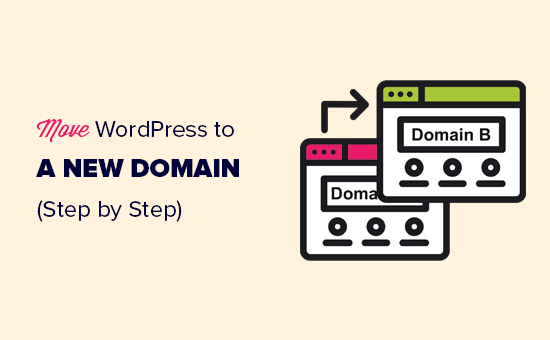
Migrer votre site WordPress vers un nouveau nom de domaine peut être effrayant, mais cela ne doit pas l'être. Nous sommes là pour vous guider à chaque étape du processus.
Vous pouvez cliquer sur l'un des liens ci-dessous pour accéder à une étape particulière de la migration de votre site WordPress vers un nouveau nom de domaine :
- Ce qu'il faut savoir avant de changer de domaine
- Pré-étapes : Ce dont vous avez besoin pour commencer
- Étape 1 : Créez un package Duplicator de votre site WordPress
- Étape 2 : Créez une base de données pour votre nouveau nom de domaine
- Étape 3 : Décompressez WordPress sur votre nouveau nom de domaine
- Étape 4 : Configurez des redirections permanentes 301
- Étape 5 : Informez Google de votre nouveau domaine
- Informez vos utilisateurs du nouveau nom de domaine
- Questions fréquemment posées sur le déplacement d'un site WordPress
- Video Tutorial
Ce qu'il faut savoir avant de changer de domaine
Avant de commencer, il y a quelques choses que vous devriez savoir.
Le processus de transfert vers un nouveau domaine affectera *temporairement* vos classements dans les moteurs de recherche, car Google et les autres moteurs de recherche devront s'adapter aux changements.
Cela affectera également temporairement votre trafic de recherche. Veuillez garder à l'esprit que c'est normal, et que cela arrive à tous les sites Web qui passent à un nouveau domaine.
Cependant, vous pouvez considérablement réduire l'impact sur le référencement en suivant ce guide. Nous vous montrerons la bonne façon de déplacer votre site WordPress vers un nouveau nom de domaine, de configurer des redirections 301 appropriées et de notifier les moteurs de recherche.
Veuillez noter que ce guide n'est pas destiné à déplacer un site WordPress vers un nouvel hôte. Il s'agit uniquement de changer de nom de domaine. Bien que le processus soit similaire, il y a quelques étapes supplémentaires. Ces étapes supplémentaires vous aideront à protéger votre classement SEO et votre trafic.
Enfin, si votre ancien site Web est sur WordPress.com, vous devez suivre les instructions de notre guide sur comment passer de WordPress.com à WordPress.org à la place.
Pré-étapes : Ce dont vous avez besoin pour commencer
Dans ce guide, nous supposons que votre site Web WordPress est configuré sur ancien-site.com et que vous essayez de le migrer vers nouveau-site.com.
Nous supposons également que vous disposez déjà d'un compte d'hébergement WordPress et que vous êtes familiarisé avec votre panneau de contrôle d'hébergement Web.
Vous devrez également savoir comment utiliser un client FTP comme FileZilla ou comment modifier des fichiers à l'aide de l'application Gestionnaire de fichiers disponible dans le tableau de bord de votre compte d'hébergement.
Si vous n'avez pas de fournisseur d'hébergement web ou si vous cherchez à en changer, nous vous recommandons d'utiliser Bluehost (idéal pour les petits sites + inclut un nom de domaine gratuit) et soit SiteGround, soit WP Engine (idéal pour les sites plus importants ou les boutiques en ligne).
Une fois que vous avez ces éléments en place, vous êtes prêt à commencer le processus !
Étape 1 : Créez un package Duplicator de votre site WordPress
La première chose à faire est de créer une sauvegarde complète de votre site WordPress.
Vous utiliserez ensuite cette sauvegarde pour créer un duplicata de votre site web afin de pouvoir configurer correctement les redirections de votre ancien domaine vers le nouveau.
Bien qu'il existe de nombreux plugins de sauvegarde WordPress disponibles, nous utiliserons Duplicator pour ce tutoriel.
Duplicator est le meilleur plugin de sauvegarde et de migration WordPress. Nous l'avons utilisé pour migrer d'innombrables sites Web pour nos propres entreprises ainsi que pour des clients. Nous avons constaté qu'il fonctionnait de manière fiable, même pour de très grands sites Web.
Remarque : Il existe également une version gratuite de Duplicator disponible, que vous pouvez utiliser pour cette migration. Cependant, nous vous recommandons de passer à un plan payant pour débloquer plus de fonctionnalités comme les sauvegardes automatiques dans le cloud, la récupération de site Web en 1 clic, des migrations plus faciles, et plus encore.
Commençons par installer et activer le plugin Duplicator sur votre ancien nom de domaine. Pour plus de détails, consultez notre guide étape par étape sur comment installer un plugin WordPress.
Une fois activé, le plugin ajoutera un élément de menu Duplicator dans votre administration WordPress. Vous devez aller à la page Duplicator » Sauvegardes, puis cliquer sur le bouton « Créer nouveau » pour créer une nouvelle sauvegarde ou copie de votre site WordPress.
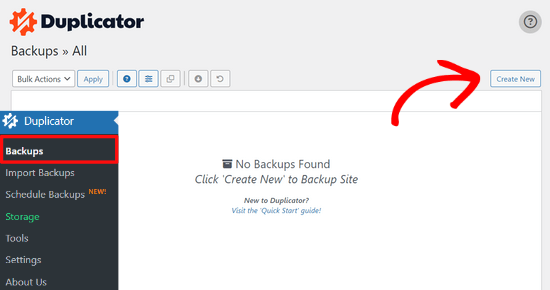
Duplicator va maintenant initialiser l'assistant de sauvegarde, il attribuera automatiquement un nom à ce package.
Cliquez sur le bouton « Suivant » pour continuer.

Duplicator va maintenant exécuter certains tests pour voir si tout est en ordre. Si le plugin trouve un problème, vous verrez un avertissement avec des instructions.
Si tous les éléments sont marqués « Bon », cliquez sur le bouton « Créer ».

Le plugin va maintenant commencer à créer un package duplicateur de vos fichiers de site web. Selon la taille de votre site, ce processus peut prendre quelques minutes.
Une fois terminé, vous verrez une option « Télécharger ». Cliquer dessus vous montrera les options pour télécharger les deux fichiers ou télécharger séparément l'installateur et l'archive (zip).
Choisissez « Télécharger les deux fichiers » pour les télécharger sur votre ordinateur.

Le fichier Archive est une copie complète de vos fichiers WordPress. Il comprend vos thèmes WordPress, les paramètres des permaliens, les plugins, les téléchargements et tout autre fichier créé par les plugins WordPress.
Le script d'installation est un fichier PHP qui automatisera et exécutera la migration WordPress en décompressant le fichier archive.
Étape 2 : Créez une base de données pour votre nouveau nom de domaine
Avant de déplacer votre site WordPress vers le nouveau domaine, vous aurez besoin d'une nouvelle base de données SQL pour décompresser WordPress sur votre nouveau nom de domaine.
Si vous avez déjà créé une base de données, vous pouvez ignorer cette étape.
Pour créer une base de données, vous devez visiter le tableau de bord de votre compte d'hébergement cPanel, faire défiler jusqu'à la section « Bases de données », puis cliquer sur l'icône « Bases de données MySQL ».
Nous vous montrerons comment le trouver sur Bluehost, mais les instructions de base sont les mêmes et devraient s'appliquer à tous les fournisseurs d'hébergement.
Connectez-vous au tableau de bord de votre compte Bluehost et cliquez sur le bouton « Paramètres » sous votre site web.
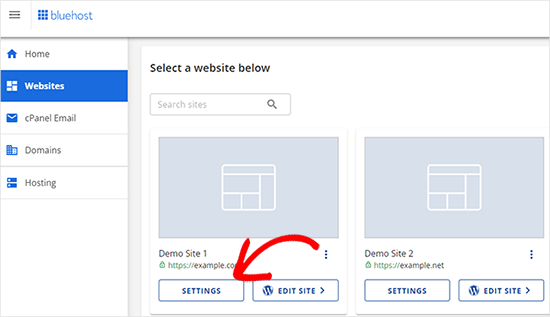
Sous les paramètres de votre site, vous devez passer à l'onglet « Avancé ».
Faites défiler un peu vers le bas jusqu'à la section cPanel et cliquez sur « Gérer ».
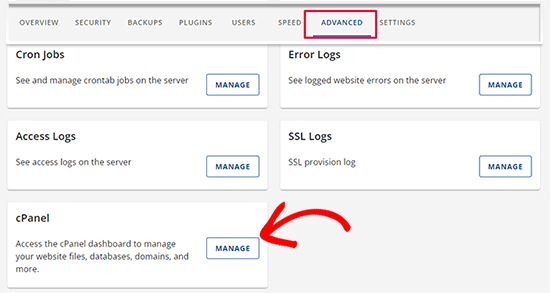
Cela ouvrira le tableau de bord cPanel.
Faites défiler vers le bas jusqu'à la section Bases de données et cliquez sur l'option « Bases de données MySQL ».
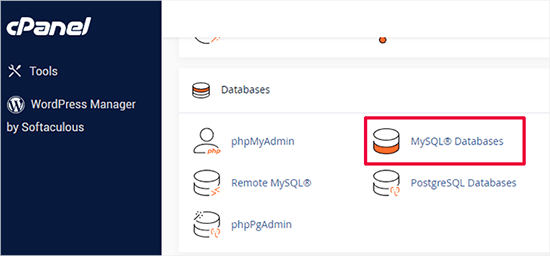
Remarque : Votre panneau de contrôle d'hébergement peut être légèrement différent des captures d'écran. Cependant, vous devriez toujours pouvoir trouver une section Bases de données avec une option pour créer une nouvelle base de données.
Fournissez simplement un nom pour votre base de données, puis cliquez sur le bouton « Créer une base de données ».
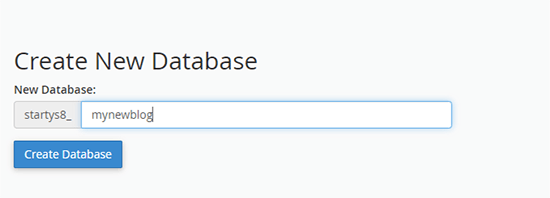
cPanel va maintenant créer une nouvelle base de données pour vous. Ensuite, vous devez faire défiler vers le bas jusqu'à la section Utilisateurs MySQL.
Ensuite, fournissez un nom d'utilisateur et un mot de passe pour votre nouvel utilisateur et cliquez sur le bouton « Créer un utilisateur ». Assurez-vous de noter le nom d'utilisateur et le mot de passe dans un endroit sûr.
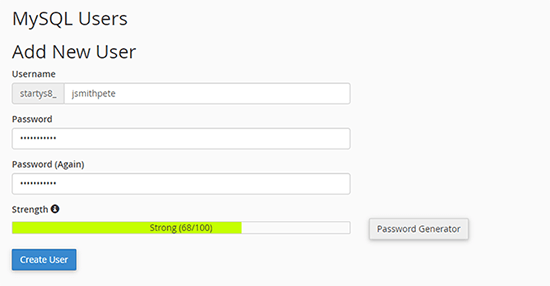
Le nouvel utilisateur que vous venez de créer n'a toujours pas la permission de travailler sur la base de données. Changeons cela.
Faites défiler jusqu'à la section « Ajouter un utilisateur à la base de données ». Tout d'abord, sélectionnez l'utilisateur de base de données que vous avez créé dans le menu déroulant à côté du champ « Utilisateur ». Sélectionnez ensuite la nouvelle base de données que vous venez de créer et cliquez sur le bouton « Ajouter ».
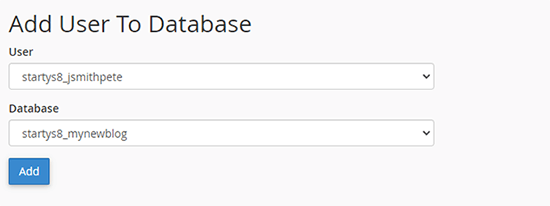
Ensuite, il vous sera demandé de choisir les privilèges de l'utilisateur.
Sélectionnez « Tous les privilèges » et cliquez sur le bouton « Apporter les modifications » pour continuer.
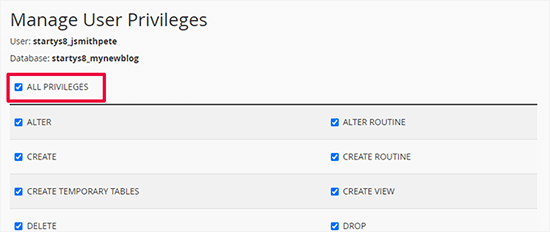
Votre base de données est maintenant prête et peut être utilisée pour déplacer WordPress vers le nouveau nom de domaine.
Assurez-vous de noter le nom de la base de données, le nom d'utilisateur et le mot de passe. Vous aurez besoin de ces informations à l'étape suivante.
Étape 3 : Décompressez WordPress sur votre nouveau nom de domaine
Maintenant, vous devez télécharger les fichiers Duplicator que vous avez téléchargés précédemment sur votre nouveau nom de domaine.
Le package Duplicator inclut également votre installation WordPress. Cela signifie que vous n'avez pas besoin d'installer WordPress sur votre nouveau domaine.
Tout d'abord, connectez-vous à votre nom de domaine en utilisant un client FTP. Une fois connecté, assurez-vous que le répertoire racine de votre site Web est complètement vide.
Après cela, vous pouvez télécharger les fichiers d'archive et d'installation dans le répertoire racine. C'est généralement appelé public_html.
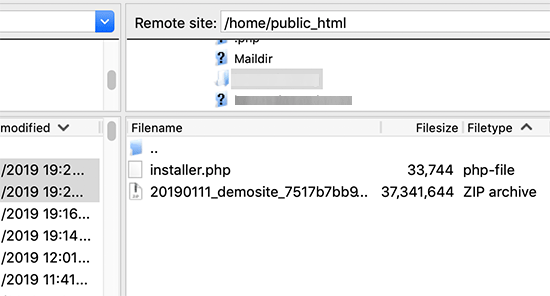
Une fois que les deux fichiers ont fini de télécharger, vous êtes maintenant prêt à décompresser WordPress.
Ouvrez un nouvel onglet de navigateur et accédez à l'URL suivante :
http://example.com/installer.php
N'oubliez pas de remplacer example.com par votre nouveau nom de domaine. Cela lancera l'assistant de migration Duplicator.
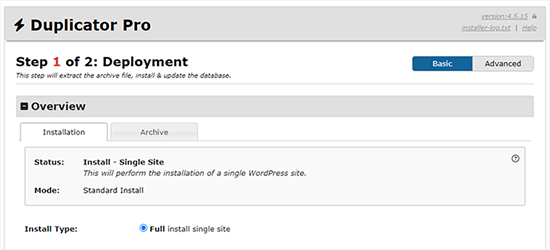
L'installateur recherchera le fichier d'archive, puis sélectionnera automatiquement les options pour vous à l'écran.
Faites défiler un peu vers le bas pour saisir les informations de la base de données que vous avez créée à l'étape précédente.
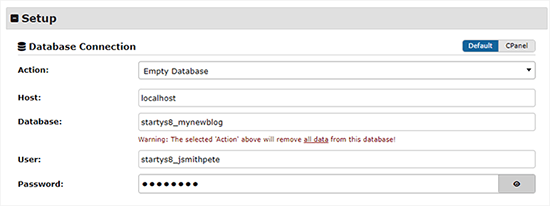
En dessous, Duplicator affichera automatiquement l'URL de votre ancien domaine et de votre nouveau domaine.
Si tout semble correct, cliquez sur le bouton « Valider » pour continuer.
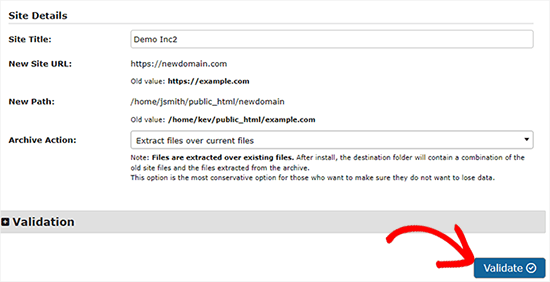
Duplicator tentera maintenant de se connecter à la base de données en utilisant les informations que vous avez fournies.
En cas de succès, il vous affichera une Validation réussie. Sinon, il vous affichera un avertissement avec des détails sur la façon de le corriger.
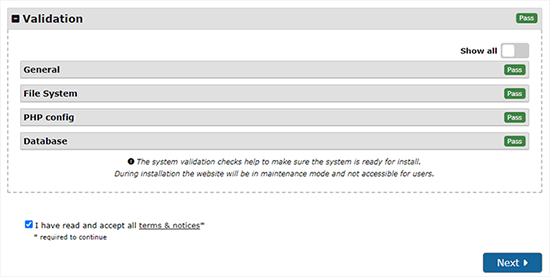
Cliquez sur le bouton « Suivant » pour continuer.
Duplicator va maintenant commencer à importer votre site WordPress. Une fois terminé, vous verrez un message de succès avec un bouton de connexion administrateur.
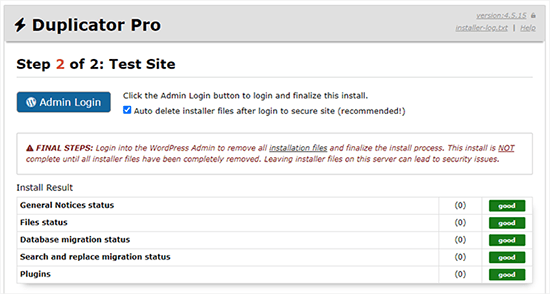
Duplicator mettra automatiquement à jour les URL vers votre nouveau nom de domaine. Vous pouvez maintenant cliquer sur le bouton « Connexion administrateur » pour terminer les étapes suivantes.
Étape 4 : Configurez des redirections permanentes 301
La prochaine étape consiste à rediriger les utilisateurs arrivant sur votre ancien nom de domaine vers le nouveau. Ceci est fait en configurant des redirections 301.
Les redirections 301 sont très importantes pour le SEO et l'expérience utilisateur. Les ajouter vous permettra de rediriger automatiquement les utilisateurs et les moteurs de recherche vers votre nouveau nom de domaine.
Autrement dit, chaque fois que quelqu'un arrive sur un article ou une page de votre ancien domaine, il sera automatiquement redirigé vers le même article ou la même page sur votre nouveau domaine au lieu de voir une erreur 404.
Pour conserver vos redirections, vous devrez garder votre ancienne installation WordPress active afin qu'elle puisse continuer à rediriger vers la nouvelle que vous venez de créer.
Il existe deux méthodes pour configurer les redirections. La première méthode est simple et ne prend que quelques clics. La seconde méthode nécessite de modifier manuellement des fichiers.
Méthode 1 : Configurer les redirections 301 avec All in One SEO
Pour cette méthode, vous aurez besoin de All in One SEO (AIOSEO). C'est le meilleur plugin SEO WordPress du marché et il vous permet d'optimiser facilement votre site WordPress pour le SEO.
Tout d'abord, vous devez installer et activer le plugin All in One SEO sur votre ancien domaine. Pour plus de détails, consultez notre guide étape par étape sur comment installer un plugin WordPress.
Remarque : Vous aurez besoin au minimum de la version Pro du plugin pour accéder au module complémentaire de gestion des redirections. Vous pouvez également configurer AIOSEO sur votre nouveau site WordPress pour améliorer encore votre classement dans les moteurs de recherche et votre trafic.
Après l'activation sur votre ancien domaine, vous devez visiter la page All in One SEO » Redirections et cliquer sur le bouton « Activer les redirections ».
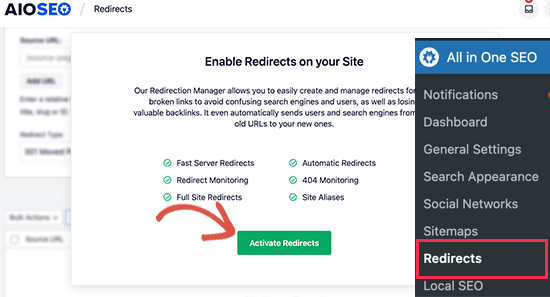
Ensuite, vous devez passer à l'onglet « Redirection de site complète » et activer le bouton « Relocaliser le site ».
Après cela, vous devez entrer le nom de votre nouveau domaine à côté de l'option « Relocaliser vers le domaine ».
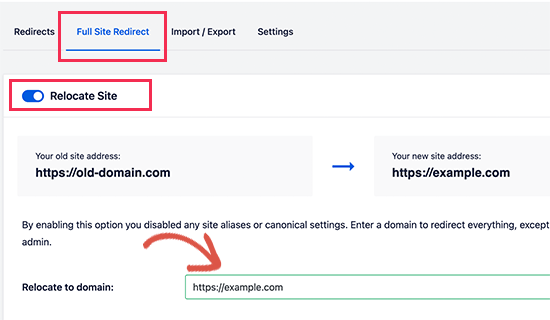
N'oubliez pas de cliquer sur le bouton « Enregistrer les modifications » pour sauvegarder vos paramètres.
Méthode 2 : Configurer manuellement les redirections vers le nouveau domaine
Cette méthode nécessite de modifier le fichier .htaccess de WordPress sur votre ancien nom de domaine.
Tout d'abord, vous devez vous connecter à votre ancien site en utilisant FTP et modifier le fichier .htaccess.
Il sera situé dans le même répertoire que vos dossiers wp-includes ou wp-admin. Ouvrez le fichier .htaccess et collez les lignes de code suivantes tout en haut :
#Options +FollowSymLinks
RewriteEngine on
Unchanged: RewriteRule ^(.*)$ http://www.newsite.com/$1 [R=301,L]
Assurez-vous de remplacer newsite.com par votre nouveau domaine dans le code ci-dessus.
Une fois que vous avez appliqué ces modifications, visitez votre ancien nom de domaine. Il devrait automatiquement vous rediriger vers le nouveau domaine.
Si ce n'est pas le cas, cela signifie que la redirection n'est pas correctement configurée et que votre serveur ne prend probablement pas en charge les règles de redirection. Vous devez contacter l'équipe de support de votre hébergeur web pour activer RewriteEngine.
Étape 5 : Informez Google de votre nouveau domaine
Maintenant que vous avez déplacé WordPress vers un nouveau nom de domaine et configuré les redirections, il est temps d'informer Google de votre changement d'adresse. Cela aidera Google à trouver rapidement votre nouveau domaine de site web et à commencer à l'afficher dans les résultats de recherche.
Tout d'abord, vous devez vous assurer que vos nouveaux et anciens domaines sont ajoutés à la Google Search Console en tant que deux propriétés distinctes. Voir l'étape 1 dans notre guide Google Search Console pour les instructions.
Ensuite, vous devez sélectionner l'ancien nom de domaine comme propriété active dans le tableau de bord de votre compte Google Search Console.
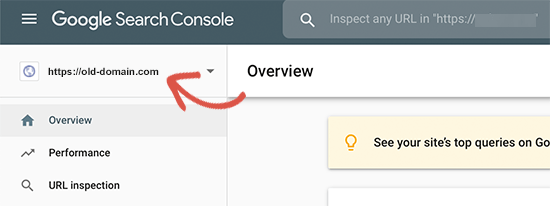
Après cela, cliquez sur le menu Paramètres dans la colonne de gauche.
Maintenant, vous pouvez cliquer sur l'outil « Changement d'adresse ».
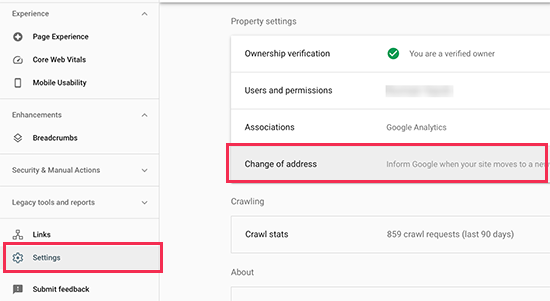
Vous devez maintenant sélectionner votre nouveau domaine dans la section Mettre à jour Google.
Ensuite, vous devriez cliquer sur le bouton « Valider et mettre à jour ».
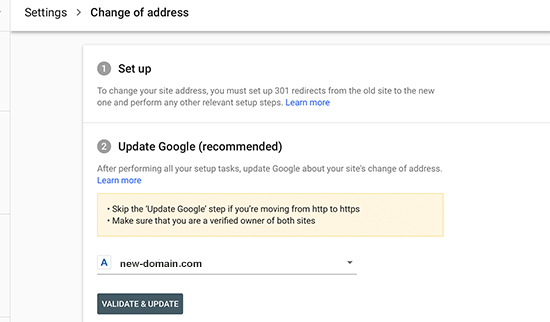
C'est tout. Google validera maintenant que votre ancien domaine redirige vers le nouveau domaine et enregistrera vos modifications.
Sur l'écran suivant, Google Search Console vous présentera un assistant étape par étape pour soumettre votre demande de changement d'adresse.
Informez vos utilisateurs du nouveau nom de domaine
Pendant que les redirections 301 font leur travail, il est toujours bon de faire une annonce publique concernant la migration.
Vous pouvez le faire simplement en écrivant un article de blog sur votre nouveau site et en le partageant sur vos comptes de réseaux sociaux.
Si vous avez une newsletter par e-mail ou des abonnés aux notifications push, alors vous devriez également leur envoyer une annonce.
Cela peut être utile de plusieurs façons.
Tout d'abord, vos utilisateurs se souviendront plus facilement du nouveau domaine une fois qu'ils en auront lu.
Deuxièmement, vous pouvez demander à vos utilisateurs de vous signaler s'ils constatent des bugs. Vous seul ne pouvez pas tester votre site dans tous les types de navigateurs ou d'environnements système, il est donc toujours utile d'avoir un regard neuf sur celui-ci.
Questions fréquemment posées sur le déplacement d'un site WordPress
Nous comprenons que vous pourriez encore avoir quelques questions sur la migration de votre site WordPress vers un nouveau domaine. Voici les réponses à certaines des questions les plus fréquentes que nous recevons pour vous donner une confiance totale dans le processus.
1. Changer le nom de mon domaine nuira-t-il définitivement à mon référencement ?
Non, cela ne nuira pas définitivement à votre référencement si vous suivez les bonnes étapes. Bien qu'une baisse temporaire des classements et du trafic soit normale pendant que les moteurs de recherche traitent le changement, ce guide est conçu pour minimiser cet impact.
En configurant correctement les redirections 301 (Étape 4) et en notifiant Google via la Search Console (Étape 5), vous indiquez aux moteurs de recherche exactement où vous avez déménagé, leur permettant de transférer votre autorité existante vers le nouveau domaine.
2. Dois-je conserver mon ancien domaine après avoir migré vers le nouveau ?
Oui, vous devez absolument garder votre ancien nom de domaine actif dans un avenir prévisible. Votre ancien domaine héberge les redirections permanentes 301 qui guident les utilisateurs et les moteurs de recherche vers votre nouveau site. Le laisser expirer briserait tous ces liens, entraînant une perte de trafic et une baisse significative de votre classement SEO.
3. Combien de temps prend l'ensemble du processus de migration de domaine ?
Les étapes techniques de ce guide, de la sauvegarde de votre site à la configuration des redirections, peuvent généralement être effectuées en quelques heures. Cependant, il faudra plus de temps aux moteurs de recherche comme Google pour explorer et indexer entièrement votre nouveau domaine. Bien que la notification à Google accélère ce processus, il peut s'écouler plusieurs semaines avant que votre classement ne se stabilise complètement après le déménagement.
4. Puis-je déplacer mon site WordPress sans utiliser de plugin comme Duplicator ?
Bien qu'il soit techniquement possible de déplacer un site manuellement en transférant des fichiers via FTP et en exportant/important la base de données, nous le déconseillons fortement à la plupart des utilisateurs.
Une migration manuelle est complexe et présente un risque d'erreurs beaucoup plus élevé, comme des mises à jour d'URL manquées ou des problèmes de connexion à la base de données. Un plugin comme Duplicator automatise ces étapes critiques, rendant le processus plus sûr, plus rapide et plus fiable.
5. Quelle est la principale différence entre passer à un nouveau domaine et à un nouvel hébergeur ?
Pensez-y comme ceci : passer à un nouveau domaine, c'est comme changer l'adresse postale de votre entreprise. Passer à un nouvel hébergeur, c'est comme changer l'entreprise qui possède le bâtiment, mais votre adresse reste la même. Ce guide est spécifiquement conçu pour changer votre adresse (domaine), ce qui implique des exigences SEO uniques, comme les redirections 301, qui sont essentielles au succès.
Tutoriel vidéo
Ressources bonus
Les articles et tutoriels suivants vous aideront à suivre et à retrouver votre classement SEO après avoir migré vers un nouveau nom de domaine :
- La Checklist Ultime pour la Migration SEO WordPress (Pour Débutants)
- Comment vérifier si vos articles de blog WordPress se classent pour les bons mots-clés
- Comment suivre les visiteurs de votre site WordPress
- Conseils pour optimiser vos articles de blog pour le SEO comme un pro (Checklist)
Nous espérons que ce tutoriel vous a aidé à déplacer votre site WordPress vers un nouveau nom de domaine. Vous pourriez également consulter notre guide sur comment obtenir un domaine d'e-mail gratuit ou suivre les étapes de notre guide complet SEO WordPress.
Si cet article vous a plu, abonnez-vous à notre chaîne YouTube pour des tutoriels vidéo WordPress. Vous pouvez également nous retrouver sur Twitter et Facebook.





L'équipe de WPBeginner
Nous ne sommes pas sûrs de cette option, nous ne l'avons pas essayée nous-mêmes, nous ne pouvons donc pas la recommander. Toute redirection que vous configurez doit être une redirection 301 afin que les moteurs de recherche puissent mettre à jour le nouvel emplacement.
vikramforever
J'ai mon domaine chez GoDaddy et ils ont une option de redirection avec correspondance de chemin mentionnée sur leur page d'aide – http://support.godaddy.com/help/article/5120/redirect-urls-with-your-hosting-account.
Est-ce une option réalisable lorsque je transfère mon site actif vers un autre domaine ? Conformément à l'option mentionnée dans l'article, je dois conserver l'hébergement de mon ancien domaine jusqu'à ce que je souhaite que les redirections fonctionnent. L'utilisation de la redirection avec l'option « correspondance de chemin » éliminerait le besoin de le faire. Mais je veux être sûr que c'est une option qui fonctionne de la même manière que le script (comme vous l'avez mentionné).
Keely Worth
Excellent – rend le processus de déplacement d'un site WordPress un jeu d'enfant. Merci.
Ayman
I’ve just migrate a website site from one URL to another. I would really like to thank you for this great post. 100% working and a very simple instructions
Anas Khan
Beau post. J'ai aussi quelques questions,
J'ai 2 blogs sur WordPress. Le nouveau blog est actif et j'ai 45 articles sur mon nouveau blog. L'ancien blog a 192 articles et tous les articles sont indexés sur Google.
Maintenant, je veux transférer et publier les 192 anciens articles sur mon nouveau blog afin que tous les articles puissent être consultés sur mon nouveau blog. Si je supprime tous les articles de mon ancien blog, retire le sitemap et l'outil webmaster de l'ancien blog et qu'après 30 jours je publie les anciens articles sur le nouveau blog en utilisant le bouton Ajouter un nouvel article, cela fonctionne-t-il ? Est-ce considéré comme du contenu dupliqué ?
Support WPBeginner
Vous pouvez simplement importer ces articles sur votre nouveau blog et configurer une redirection 301 sur vos anciens articles, article par article.
Admin
Mohammed Saimon
Oui, c'est un beau post. Merci à l'auteur.
Vinish Garg
Ceci est un excellent article et m'a donné une nouvelle direction pour déplacer mon blog WP d'un domaine à un autre. J'apprécierais si vous pouviez me corriger si je me trompe dans ma planification comme suit.
– Je connais Hostgator et je sais comment utiliser le gestionnaire de fichiers et configurer WP, la base de données et importer/exporter la base de données (fichiers XML)
– Mon blog WP actuel est à : http;//www.example.com, et je veux le déplacer vers un autre domaine http://www.example.org.
– Premièrement, je vais configurer un nouveau WP sur la racine du nouveau domaine (base de données, fichier de configuration, thème personnalisé, et importer le fichier de données de l'ancien site)
– Le nouveau site affichera le site exactement comme l'ancien site, MAIS la seule différence sera l'URL (à cause du nouveau domaine).
Si tout est correct jusqu'à présent… Je ne suis pas sûr de la façon d'utiliser les redirections pour toutes les pages/articles de mon ancien domaine vers le nouveau domaine. Pouvez-vous s'il vous plaît me conseiller ?
Support WPBeginner
Vous pouvez le faire en suivant l'étape 3 de ce guide, en configurant des redirections 301.
Admin
Stefan
Excellent article, malheureusement je l'ai lu trop tard et j'ai déjà déplacé mon domaine. Tout ce que j'ai fait, c'est que j'ai acheté un nouveau domaine pour mon blog (, avant c'était il est toujours actif pendant encore 2 mois). J'ai changé l'URL de Wordpress et l'adresse du site dans les paramètres généraux de Wordpress et j'ai soumis à nouveau le sitemap avec la nouvelle URL. C'est tout ce que j'ai fait.
C'était il y a un mois et depuis lors, le trafic a complètement chuté, passant de plus de 1 000 pages vues par jour à moins de 200.
Si je recherche sur Google « thailand redcat », aucune de mes pages n'apparaît. Le sitemap a cependant été soumis avec succès :
14:51:35Stefan
Savez-vous quelle pourrait être la raison de cela et comment puis-je résoudre le problème et retrouver les résultats de recherche et éventuellement le trafic à la normale ?
Toute aide serait grandement appréciée. Merci !
Support WPBeginner
Stefan, nous ne sommes pas sûrs de comprendre le processus que vous avez suivi pour déplacer votre site vers un nouveau domaine. Voici quelques conseils généraux. Assurez-vous d'abord que les robots d'exploration peuvent explorer et indexer votre site ? Vérifiez votre site dans les outils pour webmasters de Google pour les erreurs d'exploration.
Admin
Charlie
J'ai le même problème. Les robots d'exploration de Google rencontrent une erreur 500 sur tout le site depuis la migration. J'ai essayé sur 2 environnements/fournisseurs différents, différentes versions de PHP, j'ai essayé de désactiver/réactiver tous mes plugins un par un, j'ai essayé de régénérer les permaliens, le htaccess, le robots.txt… rien ne fonctionne.
M. Joy
Merci pour votre excellent article. J'ai suivi votre article et déplacé mon site vers un nouveau domaine. Tout fonctionne bien, mais il y a un seul problème sur mon site concernant l'éditeur visuel de WordPress. Le problème est : « Lorsque je télécharge une image sur un article via l'option Ajouter un média, puis que je clique sur la miniature de l'image « modifier l'image », un iFrame apparaît avec une erreur Not Found. Mais lorsque je clique sur supprimer, cela fonctionne. Aidez-moi à résoudre le problème. Regardez la capture d'écran : http://bit.ly/1fqjE1b
Support WPBeginner
La première chose que vous pouvez essayer est de mettre à jour vos permaliens, allez simplement dans Paramètres » Permaliens et cliquez sur le bouton Enregistrer les modifications.
Admin
AP
Excellent travail – merci beaucoup ! Il pourrait être utile d'ajouter la réponse ci-dessus – celle qui traite de la création et de l'utilisation d'une nouvelle base de données – aux instructions initiales, car tout le monde ne lira pas les commentaires avant de tenter un transfert.
Gary Kirwan
Excellent article. Ma question est la suivante : j'utilise la méthode de masquage d'affiliation recommandée par Yoast, ce qui signifie que j'ai un fichier .htaccess sous un dossier appelé /out/
Dois-je ajouter le même code de redirection 301 mentionné dans l'article aux deux fichiers .htaccess, celui du répertoire racine et celui du sous-dossier des liens d'affiliation ? L'ajout du code de redirection 301 au fichier .htaccess du répertoire racine couvre-t-il automatiquement celui des sous-dossiers ?
Mon objectif est de m'assurer que les liens d'affiliation externes fonctionnent correctement également.
Kingsley
Excellent tutoriel, je vais l'utiliser pour migrer http://www.ideacrunch.org vers http://technblogging.com dans les prochains jours, mais j'ai une question. Le mot de passe et le nom d'utilisateur de la base de données seront-ils les mêmes que pour l'ancien site ?
Craig
Bonjour, je sais que c'est un peu tard. Mais je veux juste passer de http://www.unlockworldtv.co.uk à http://www.unlockworldtv.com. Ce tutoriel est-il adapté pour cela ? Je ne change pas d'hébergeur, juste l'URL.
Support WPBeginner
Oui, il l'est.
Admin
Craig
Merci. Je suis bloqué à l'étape go to newsite.com/installer.php, j'obtiens juste mon ancien site mais avec une erreur 404. Je n'ai pas installé wp dans le nouveau répertoire, j'ai juste créé un répertoire vide pour y mettre l'installateur et le zip. Je fais pointer mon nouveau domaine depuis mon compte registrar vers ce nouveau répertoire chez mon hébergeur, mais je n'obtiens rien d'autre que le thème et une erreur 404. Des conseils évidents ?
Craig
Juste pour info, j'ai résolu ce problème. Il semble y avoir un problème avec 1&1 (sans surprise), mais cela peut être résolu en ayant un fichier index.html présent. Donc, pour quiconque utilise 1&1, ajustez l'étape 2 à partir de
« Assurez-vous que le répertoire racine, ou le répertoire où vous souhaitez copier votre site Web, est complètement vide, à l'exception de installer.php, du fichier .zip ET d'une page index.html »
Je pense que cela est lié à la façon dont 1&1 priorise les pages sur leur serveur.
Denis Fitzgerald
Bonjour – Merci pour l'article. J'ai une question : je suis en train de migrer mon site de Tumblr vers Wordpress. Il a son propre domaine. Je voudrais savoir si les boutons à la fin de chaque article affichant les partages sociaux, Twitter, Facebook, Google+, conserveront le nombre de partages d'origine ou reviendront à zéro. Merci.
Support WPBeginner
Si le domaine est le même et que votre structure d'URL reste intacte, alors j'espère que vous pourrez conserver ces décomptes sociaux.
Admin
Bertjan
Excellent guide ! Merci beaucoup.
Sudha Mathew
Bonjour, j'ai déplacé mon site en utilisant des redirections il y a environ 6 mois et cela fonctionne bien. Je dois renouveler mon contrat avec la société de sécurité web bientôt. J'ai donc besoin de savoir combien de trafic est encore redirigé depuis l'ancien site. Pourriez-vous m'expliquer comment faire ? Je ne suis pas un expert en technologie mais je peux utiliser les outils Webmaster et Google Analytics. Merci d'avance !
Meilleur
Sudha
Moti
Bonjour,
Je voudrais changer le nom de domaine de mon site (en restant sur le même hébergeur).
Dans les instructions ci-dessus, il est indiqué que je dois « vous assurer que le répertoire racine, ou le répertoire où vous souhaitez copier votre site Web, est complètement vide. ».
Dans mon cas, WP est installé dans le répertoire racine (j'ai le dossier wp-content sous public-html) – je suppose que cela signifie que mon WP est installé sous le répertoire racine.
Quels dossiers dois-je nettoyer / supprimer avant d'exécuter le fichier installé généré par le duplicateur ?
Merci,
Moti.
Declan
Merci pour le tutoriel. A fonctionné à merveille sans aucun problème.
J'ai, bien sûr, une question concernant le SEO.
Mon ancien site n'était pas enregistré dans les outils Google Webmaster, donc évidemment il n'y a pas d'option pour les informer des changements que j'ai apportés. Ma question est : dois-je d'abord enregistrer mon ancien domaine auprès des outils Google Webmaster, puis mon second domaine… et ensuite les informer des changements ?
Vos réflexions seraient les bienvenues.
Merci encore pour l'article, il a été extrêmement utile.
Declan.
Support WPBeginner
Oui, vous devrez signaler le changement dans le compte des outils Webmaster de votre ancien site. Cependant, c'est juste le moyen le plus rapide de le faire. Si vous avez configuré vos redirections 302, les moteurs de recherche le détecteront également.
Admin
reza
salut,
cela fonctionne très bien, je redirige mon ancien.com qui est mon domaine principal vers nouveau.com qui est un domaine supplémentaire (dans le même hébergement)
mais quand j'ai ajouté un autre nouveau domaine supplémentaire, mon nouveau domaine supplémentaire n'est plus accessible... il redirige toujours mon addon.com vers nouveau.com/addon.com...
pouvez-vous aider ??
Jennifer @ Delicieux
Merci de l'avoir expliqué si en détail. J'ai cependant une question. J'envisage de changer de nom de domaine depuis un certain temps, mais je voulais savoir si j'aurais des problèmes étant donné que plus tôt dans l'année, j'ai modifié la structure des permaliens de mon ancien blog.
J'ai suivi les instructions de Yoast sur la façon de modifier ma structure de permaliens et j'ai modifié mon fichier .htaccess, et je me demande si cela causera des problèmes lorsque je passerai à un nouveau domaine ? C'est la seule chose qui me retient car je ne veux pas que les choses se gâchent, que je perde mon classement et que je me retrouve avec des liens brisés.
Support WPBeginner
vous pouvez transférer votre ancien fichier .htaccess vers votre nouveau site. Si le fichier .htaccess contient des références à l'ancien nom de domaine, remplacez-les par le nouveau nom de domaine et tout ira bien.
Admin
Hrayr
Salut,
Tout d'abord, merci beaucoup pour cet article – il a fonctionné parfaitement pour moi sans aucun problème !
J'ai une question simple spécifique à mon cas, j'apprécierais grandement votre avis à ce sujet.
En gros, j'ai utilisé cette approche pour copier mon site WordPress de localhost vers l'hôte/domaine d'un tiers.
Comme je l'ai dit, tout a bien fonctionné – je veux juste m'assurer que cette approche ne laisse aucune ancienne URL/lien/référence qui pourrait « agacer » Google lors de l'exploration de ce nouveau site. Mon site est assez basique, donc dans le pire des cas, je peux simplement le recréer s'il y a un inconvénient en termes d'exploration/SEO lorsque le site est copié par Duplicator.
Connaissez-vous des problèmes de SEO connus pour le nouveau site ?
Support WPBeginner
Nous ne sommes pas au courant de problèmes de SEO, mais si vous en rencontrez, vous pouvez en informer l'auteur du plugin en ouvrant un fil de support sur la page du plugin.
Admin
Kevin
Je ne pense pas que la façon dont vous suggérez aux utilisateurs de faire leur redirection 301 soit la meilleure. Il est bien documenté, même recommandé par Google, de faire des redirections page à page, ET NON de rediriger toutes les pages de votre ancien site vers la page d'accueil du nouveau site. Le code htaccess que vous fournissez fait cela. Ce n'est pas une bonne façon de préserver le jus de lien.
Peut-être pouvez-vous nous référer à un bon tutoriel htaccess à la place ? Il existe également des générateurs htaccess en ligne qui peuvent accélérer la création de redirections page à page.
Support WPBeginner
Kevin, vous avez raison et les règles de réécriture dans l'article font exactement cela. Au lieu de rediriger les utilisateurs vers la page d'accueil, elles les envoient vers la page individuelle. Le $1 à la fin du code ajoute le lien avec la structure de permalien appropriée.
Admin
Julian
Salut, quand je fais cela après le « déploiement », la section « mise à jour » est ignorée et cela revient à une page 404 à l'ancienne adresse web… une idée de ce qui pourrait causer cela ?
Merci beaucoup !
Munna
Thank you very much for this post. I was in trouble redirecting my oldsite visitors to the new site. But your .htaccess code made it super easy because both sites were in the same hosting server.
Raspal
Bonjour,
J'ai terminé toutes les étapes et le blog sur le nouveau site fonctionne bien. Mais je ne peux pas me connecter à la zone d'administration. J'ai deux utilisateurs, dont un est un administrateur. J'obtiens cette erreur en essayant de me connecter :
« ERREUR : Les cookies sont bloqués ou non pris en charge par votre navigateur. Vous devez activer les cookies pour utiliser WordPress. »
J'ai essayé différents navigateurs et j'ai aussi essayé de supprimer les cookies. J'ai aussi essayé de changer le mot de passe. Le mot de passe a été changé sans problème mais j'obtiens toujours l'erreur ci-dessus.
Pouvez-vous m'aider au plus vite ?
Utilisation de la version WP 3.7.1
Cordialement,
Raspal
Neil Bargas
Merci mec ! 100% fonctionnel et instructions très simples.
Lynn
Fantastic article! You are my hero of the day.
Jahid
« Connectez-vous à l'administration WordPress de votre nouveau site en utilisant le même nom d'utilisateur et mot de passe que vous aviez sur l'ancien site. Allez dans Réglages » Permaliens dans l'administration WordPress de votre nouveau site et cliquez sur le bouton Enregistrer. »
Une fois connecté, la page de la première étape « Étape 1 : Fichiers & Base de données » s'affiche au lieu du tableau de bord WordPress. Aide !
Support WPBeginner
Il semble que vous deviez mettre à jour votre fichier wp-config.php
Admin
Chrissy
Salut ! Merci beaucoup pour cet article utile – je suis en train de suivre les étapes maintenant.
Ma seule question est :
J'ai mon blog hébergé sur un domaine, appelons-le http://www.reallylongdomainname.com/blog, mais j'ai une redirection pour le transférer vers mon autre domaine : blog.shortername.com. Je veux maintenant migrer le blog vers shortername.com/blog, car certains liens ne fonctionnent pas après la redirection.
Tous mes articles et autres contenus ont déjà des permaliens sur shortname.com/blog/post#, donc ai-je vraiment besoin de faire tout ce truc de redirection 301 ? Suis-je en sécurité si je saute les étapes 3, 4 & 5, ou y a-t-il quelque chose que je dois considérer ? Et devrai-je supprimer l'ancien blog ou juste la redirection une fois que je l'aurai lancé sur le nouveau domaine ?
Ce serait vraiment formidable de savoir comment procéder, car j'ai essayé des dizaines de choses cette semaine et aucune situation n'est tout à fait la même que la mienne :/ Merci !
Support WPBeginner
Le but des redirections 301 est non seulement de rediriger les utilisateurs, mais aussi de faire savoir aux moteurs de recherche que vous avez déménagé vers le nouvel emplacement, donc les étapes 3 et 4 sont indispensables, sinon cela pourrait affecter vos classements SEO.
Admin
Mark P
Excellent article. Une question cependant.
Disons que quelqu'un clique sur un backlink de l'ancien domaine de mon site web. (Appelons-le olddomain point com / blogpost1). Sera-t-il alors redirigé vers le lien correspondant du nouveau domaine (newdomain point com / blogpost1) au lieu de simplement être redirigé vers la page d'accueil du nouveau domaine ?
Support WPBeginner
Oui, cela redirigerait les utilisateurs arrivant sur vos articles et pages de l'ancien site vers les articles/pages du nouveau site.
Admin
Mark P
Merci !
Morgan
Question : Je suis en train de transférer mon site d'un hébergeur à un nouvel hébergeur. En même temps, je change de nom de domaine. J'ai déjà transféré avec succès mon site WordPress vers mon nouvel hébergeur en utilisant le nouveau nom de domaine. J'en suis maintenant à l'étape 3 et je veux utiliser des redirections 301 pour pointer ces anciennes URL vers les nouvelles URL du site. Cependant, l'ancien site est sur l'ancien hébergeur et je prévois de m'en débarrasser.
Les redirections 301 fonctionneront-elles toujours ? Ou dois-je aussi déplacer l'ancien site vers mon nouvel hébergeur et ENSUITE faire les redirections ? Je ne suis pas très sûr de ce qu'il faut faire et j'aimerais avoir des conseils.
Support WPBeginner
S'il vous est possible de maintenir l'ancien site en ligne pendant au moins un mois, vous pourrez alors ajouter la redirection 301. Après cela, mettez à jour les informations de votre site sur Google Webmaster Tools. Une fois que vous aurez retrouvé votre classement et votre trafic de recherche, vous pourrez alors fermer votre compte auprès de l'ancien hébergeur web.
Admin
Nj
Thank you for the helpful posts, but sometimes with such plugins, a video will help A LOT. I hope you will consider this
Thanks again
Arnold
Bonjour. Pourriez-vous s'il vous plaît préciser la partie où vous avez dit « L'installateur vous demandera de fournir les informations de la base de données pour le nouveau site et de cocher la case pour la suppression des tables ? » Où puis-je trouver ces informations de base de données ? Dois-je donc cocher la case pour la suppression des tables ? Merci !
Support WPBeginner
C'est la base de données à partir de laquelle vous importerez votre ancien site à partir du package que vous avez créé précédemment. Connectez-vous à votre tableau de bord d'hébergement web, trouvez phpmyadmin et créez une nouvelle base de données. Revenez à installer.php et fournissez le nouveau nom de base de données, l'hôte, l'utilisateur et le mot de passe.
Admin
Kara Lumsden
Donc, vous ne devriez pas installer WordPress à la racine du nouveau domaine ? La seule chose que vous devez faire sur le nouveau domaine est de créer une nouvelle base de données, est-ce correct ? Pouvez-vous m'en dire un peu plus sur la façon de créer la base de données dans phpMyAdmin ?
Tellement reconnaissant, merci pour tout ce que vous faites !
Support WPBeginner
Non, il est possible d'installer WordPress à la racine du nouveau domaine. Oui, vous devez juste créer une nouvelle base de données et Duplicator s'occupe du reste.
Kara Lumsden
Pouvez-vous s'il vous plaît fournir des instructions sur la façon de créer la base de données ?
Merci beaucoup,
Kara
Dennis J. Smith
Combien de temps faut-il attendre avant de supprimer l'ancien site ?
Support WPBeginner
30 à 90 jours, cela dépend du succès de votre migration. Si vous êtes confiant que votre nouveau domaine a acquis presque le même trafic que l'ancien site, alors vous pouvez le supprimer.
Admin
dyer
Bonjour, j'ai rencontré un problème. Je ne parviens pas à enregistrer mes permaliens car je ne trouve pas le fichier WP admin. J'ai essayé de téléverser à nouveau le fichier WP admin mais cela n'a pas résolu le problème. Pourriez-vous me conseiller s'il existe d'autres étapes que je peux suivre pour résoudre ce problème.
Merci
Dyer
Support WPBeginner
@dyer Nous ne parvenons pas à comprendre votre question. Nous supposons que vous ne pouvez pas accéder à votre espace d'administration WordPress. Dans ce cas, connectez-vous à votre site à l'aide d'un client FTP comme FileZilla. Trouvez le fichier
.htaccess, téléchargez-le sur votre disque dur et supprimez-le de votre site Web. J'espère que cela résoudra votre problème.Admin
Fakhre
Merci pour l'article les gars !
J'héberge mon site sur Bluehost et je veux juste changer le nom de domaine sans perdre le SEO et les backlinks.
Le contenu de mon site est énorme, j'ai environ 8000 articles. Une solution pour renommer le domaine ??
Sanjay Patel
Bonjour…
Informations vraiment utiles mais le plugin duplicator ne fonctionne pas sur mon site web. S'il vous plaît, résolvez mon problème. Comment faire cela ?
Merci d'avance.
Dinah
Cela fonctionne-t-il pour passer d'un domaine à un sous-domaine ?
Personnel éditorial
Oui
Admin
Dinah
Est-ce que cela fonctionne pour un déménagement vers un nouveau sous-domaine ? Par exemple, si mon blog WordPress était sur ancien.com et que je voulais le mettre sur blog.nouveau.com, est-ce que je ferais la même chose ?
Personnel éditorial
Oui.
Admin
Emmie
Je l'ai fait récemment et les liens et tout se sont redirigés sans problème, cependant je viens d'être frappée par Google avec une pénalité pour avoir instantanément autant de backlinks – ils pensent que je les ai achetés. Quelqu'un d'autre a-t-il rencontré cela ? J'ai fait les notifications appropriées dans les outils pour webmasters de Google avant de déménager, et cela n'a rien fait pour aider. Cela m'a durement touchée, donc si quelqu'un a de l'expérience pour remédier à cela, partagez s'il vous plaît !
Personnel éditorial
Salut Emmie, où vois-tu que tu es frappée pour avoir trop de backlinks ? Est-ce que cela t'affiche cette erreur dans tes Outils pour webmasters ? J'essaie juste de comprendre comment tu es arrivée à la conclusion que tu as été pénalisée par Google.
https://www.google.com/webmasters/tools/reconsideration << C'est la page où vous pouvez envoyer une demande de réexamen à Google.
Admin
Lateef Adewale
Avez-vous une idée si cela fonctionnera si je déplace un site de Bluehost vers Wp Engine.
Personnel éditorial
Oui, cela devrait fonctionner.
Admin
Emily
Je viens de passer par tout ce processus, cela a parfaitement fonctionné et c'était exactement ce que je devais savoir. Merci WPBeginner ! Le seul problème que j'ai rencontré était de ma faute – je n'avais pas désactivé mes plugins de sécurité en premier, donc j'ai dû tout refaire. Maintenant, je suis une experte... : )
Sandra Christie
Merci pour l'article !
Les étapes pour déplacer le même domaine vers un nouvel hébergeur sont-elles globalement les mêmes ? Et cela peut-il également entraîner une baisse du SEO ?
Travis Pflanz
De plus, l'option « Changement d'adresse » dans les Outils pour webmasters se trouve maintenant dans le menu Options en haut à droite dans l'icône d'engrenage.
Zach Smith
Merci de publier un autre excellent article pour nous. C'est le meilleur pour tout blog lié à la technologie.
Bob
Merci – c'est une excellente information. Je suis vraiment impatient d'en apprendre davantage sur Duplicator. Bien que le déplacement d'un domaine soit quelque chose que je pourrais avoir à faire occasionnellement, je clone constamment des environnements à des fins de développement et de test. Le processus de clonage manuel que j'utilise est long et potentiellement source d'erreurs. Duplicator a le potentiel d'être une amélioration considérable !
Sam
Je viens de déplacer WP vers un nouveau domaine et serveur en utilisant cette méthode. Webmaster Tools affiche maintenant de nombreuses erreurs 403 sur le nouveau serveur pour chaque dossier dans uploads, comme wp-content/uploads/2012/07 et une erreur 403 pour chacun des mois. Sur mon ancien serveur, je n'avais pas cela. En déplaçant le site, devons-nous également modifier ou vérifier les permissions ? Quelles devraient-elles être pour le dossier wp-content/uploads ?
Personnel éditorial
Google ne devrait pas indexer les dossiers, mais plutôt les fichiers qu'ils contiennent. Si vous essayez d'accéder directement au dossier via un navigateur, WordPress vous renverra une erreur 404. Vous ne voulez pas autoriser l'accès à un répertoire qui n'a pas de page d'index, ce qui produirait alors une liste de répertoires qui serait indexée et explorée, y compris les liens vers tous les fichiers.
Admin
sam
Merci pour votre réponse. Alors pourquoi Google affiche-t-il une erreur 403 pour les dossiers dans Webmaster Tools ? Cela ne signifie-t-il pas que quelque chose ne va pas ?
Zimbrul
C'EST L'ARTICLE QUE JE CHERCHE DEPUIS 1 AN !!
Personnel éditorial
Better late than never
Admin
Jasim Ahmed
Duplicator est un excellent plugin mais le problème est qu'il ne fonctionne pas avec certains serveurs car il nécessite une version PHP plus élevée, à part cela, y a-t-il un autre moyen de le faire ?
Personnel éditorial
Oui, vous pouvez télécharger manuellement les fichiers et la base de données. Téléversez-les sur le nouveau domaine. Remplacez toutes les anciennes occurrences d'URL dans la base de données en utilisant la requête de recherche et remplacement SQL de phpMyAdmin. La solution la plus simple serait de demander à votre hébergeur pourquoi ils ne sont pas sur les versions PHP plus élevées ou de passer à un meilleur hébergeur.
Admin
iAn
salut, je crois que cela ne conservera pas vos compteurs de partage de réseau social (nombre de partages et de likes). Avez-vous une idée pour conserver ces compteurs de popularité ?
Personnel éditorial
Vous ne pouvez pas conserver les compteurs sociaux car ils dépendent de vos URL canoniques qui seront le nouveau site (très important pour le SEO). Les compteurs sont principalement pour la preuve sociale. Tous les liens existants sur les réseaux sociaux redirigeront correctement, vous ne perdrez donc aucun trafic.
Admin